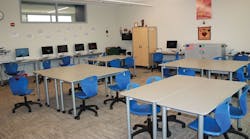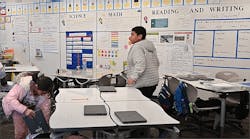A classroom or an office is just an empty space until school planners decide what should go inside. The types of desks, chairs, tables, shelves and other furnishings that a school or university chooses will determine whether a space becomes a place where people can do their jobs effectively. For a classroom, that means a space where teachers teach and students learn successfully, and for an office, it means an area where staff members can work productively to support the educational mission.
Furniture in educational settings needs to have a long life, enable users to carry out their tasks in comfort, have the flexibility to adapt to the varying needs of its users, and come at a cost that does not drain a school system’s limited resources.
Made to last
Education institutions typically are around for a long time, so when administrators acquire furniture for classrooms and other learning spaces, they expect that it will hold up to years of wear and tear from students.
In the same way that facility planners have begun to pay more attention to more than just the initial cost of constructing a school, administrators choosing classroom and office furnishings need to look beyond the retail pricetag. A less expensive desk that looks shiny and pristine when it arrives in a classroom may not seem like such a bargain after it has endured a few semesters in the company of energetic students.
School officials should conduct research on the furnishings they are considering to see what their track record is for durability and safety over time. For educational seating, an industry standard for safety and performance has recently been established. (See sidebar)
Comfort requirements
Students spend several hours a day in their classrooms, so it’s important to have furniture that enables them to maintain good posture.
Ergonomic issues have become a more critical issue in classroom furniture because of the changing nature of student activities during a school day. Children who used to sit in their desks or chairs while teachers lectured or wrote on a chalkboard are now tapping out letters on a keyboard or staring at a computer monitor for long stretches. Elsewhere in education institutions, office workers and other employees also are logging many hours in front of a computer.
All that screen time can lead to health problems if the furniture doesn’t enable students and staff members to adopt the proper posture or align themselves properly as they sit at their workstations. The U.S. Occupational Health and Safety Administration provides recommendations for setting up computer workstations properly:
•The workstation chair should be easily adjustable—for height and depth of the seat and how much the chair tilts. It should have a sturdy five-legged base to make tipping difficult. A chair should have casters that enable the chair to move easily on the floor surface, whether hard flooring or carpet. The chair should be able to swivel so users can get to items nearby without twisting their bodies.
•Chair edges should be padded and contoured for comfort, and the front edge of a seat pan should have a “waterfall” design to prevent unwanted pressure or discomfort at the back of a user’s legs or behind the knees. The backrest of a chair should provide lumbar support that matches the curve of the user’s lower back. A chair’s armrests should be adjustable to accommodate multiple users, should be padded and soft, and should be large enough to support a user’s forearm without interfering with the work surface.
•The furniture setup should enable users to have enough leg room to move without restriction The minimum under-desk clearance depth should be 15 inches for a user’s knees and 24 inches for feet. Clearance width should be at least 20 inches, OSHA says.
Flexible fit
Students have different styles of learning and may benefit when they don’t have to sit in the same configuration for long periods. Classroom furniture that can be moved and rearranged enables teachers to change their instructional style to better engage students. Altering a student’s learning routine by repositioning classroom furniture may lead to better focus on studies and spark creativity.
Among the flexible arrangements to consider: tables or chairs that can be pushed together to create spaces for larger groups to work together; and chairs that can be stacked on top of each other to quickly create an open space for varied activities.
Some classroom seating will benefit from casters so that students can move them smoothly through a learning space. Other furnishings, such as shelves and cabinets, also can be put on wheels to provide even more space flexibility.
One way to change up the classroom environment for students is to establish areas where students can go off by themselves for individualized activities. Many teachers have created reading nooks in their classrooms where students can get away from the more formal desk setting and read in a more leisurely and laidback setting. Schools may want to outfit these spaces with pillows, blankets, sleeping bags, beanbag chairs or other cozy seating choices.
Affordability
For most schools and universities, the factor that overrides others when seeking educational furniture is cost. Education institutions almost never are in a position to splurge on furniture and other classroom and office equipment, but the budgetary squeeze that has thwarted facility improvements at countless campuses makes financial considerations even more critical.
Buying in large quantities may enable a school system to find more favorable prices when outfitting their classrooms and other spaces. Schools that don’t need to buy in large quantities may be able to team up with other institutions or government entities in purchasing cooperatives to buy furnishings at better rates than would be available to individual institutions.
Sidebar: Seating standards
The first-ever safety and performance standard for educational seating has been established, the Business and Institutional Furniture Manufacturers Association (BIFMA) says.
The American National Standards Institute has approved the standard, which was created by the BIFMA Seating Subcommittee. BIFMA used existing seating standards as well as developing unique tests relevant to the educational environment.
To show that their educational seating conforms to the safety and performance standard, seating manufacturers have to submit their products to third-party accredited labs for testing.
“To meet the standard, a product has to pass all of the applicable tests,” says BIFMA executive director Tom Reardon.
The specific tests will vary depending on the product, and will measure such characteristics as stability, backrest strength, backrest durability, seat load and durability, arm strength and durability, leg strength, tablet-arm function, desktop loads and performance of casters and swivels. The standards are based on a product having a 10-year useful life, Reardon says.
Kennedy is staff writer for AS&U.


